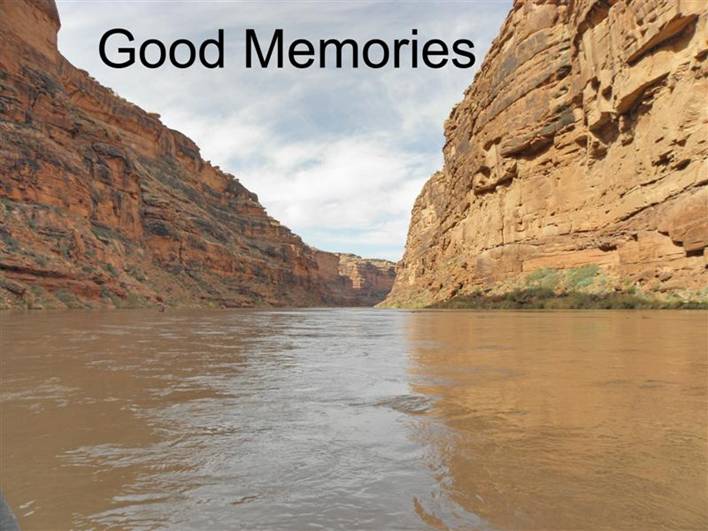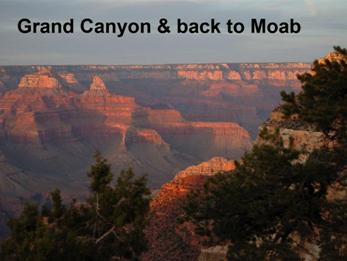Note – Maximize the window for correct display. Adjust browser zoom to fit if necessary.
SOUTHWEST USA April, 2010
Grand
Junction, Colorado: April 7- 9, 2010
Wednesday, April 7, 2010
Travelling to Grand Junction, Colorado
We
arrived in Grand Junction as the sun was setting on the spectacular mesas. A beautiful spot. Looking forward to
discovering it.


Thursday, April 8, 2010
Grand Junction, Colorado
Colorado National Monument: Rim Rock Drive
What
a good idea to arrive here in Grand Junction a few days ahead of our canoe
trip.
We
selected a motel near the airport and beside a canal. Although we had selected
the smallest/cheapest car to rent, we got a recent Ford Explorer van. We quickly
realized that everyone here drives trucks or large vans. Quite a change for us
from the basic Dodge! We wanted to lower the back seats to create more space
but could not find the manual pulls. Finally we spotted a button on the side
and – presto! And gas fill up with no gas cap! 

We
started the morning with a hike along the canal for some Colorado birding to
discover the same common birds we have, except for the Black-billed Magpie.


Today
was an amazing canyon discovery day as we drove the Rim Rock Drive. We hopped
in our luxury van and travelled for about half an
hour to the Colorado National Monument, a US national park. We made a short
stop as we crossed the blue Colorado River because we spotted some ducks by the
shore. Alas, only some Mallards, Common Mergansers and Canada Geese.




At
the Visitor Centre, a ranger suggested one of the best places for bird hiking
was just behind the centre, so we spent the morning there. I loved the campground
in the mountains, nobody here yet as it is still quite cool – hovering close to
freezing overnight. Some snow still on the higher peaks. But
what a place to camp – on the edge of the Saddlehorn
canyon with magnificent vistas.








Many more canyons with incredible natural sandstone carvings, many of
them with special names. The weather turned very warm and we soon noticed others in shorts.
There were several hard core bikers maneuvering the tight switchbacks and long
climbs – just like in New Zealand. Mountain biking is popular here too.
As
an end to our day we sampled some of the local Plum Creek wine and found it
excellent.
![]() First
Birds: April 8
First
Birds: April 8
Hotel, Grand Junction


1. Black-billed Magpie
2. American Robin
3. Common Raven
4. Red-winged Blackbird
5. Rock Pigeon
6. European Starling
7. Purple Martin ?
8. House Sparrow
9. Eurasian Collared Dove
Rim Rock Drive






10. Mallards
11. Common Merganser
12. Canada Geese
13. Pinyon Jay
14. Scrub Jay
15. White-throated Swift
16. Juniper Titmouse
17. Downy Woodpecker
18. Mountain Chickadee
19. White-breasted Nuthatch
20. Dark-eyed Junco (Oregon type)
21. Gambel’s Quail
22. Say’s Phoebe
Friday, April 9, 2010
Grand Junction, Colorado
Colorado
National Monument: Devil’s Kitchen, Serpent’s Trail
We
decided to try a couple of longer hikes to examine nature in more detail. We
were able to get right in the Devil’s Kitchen.














We
also wound our way up the steep Serpent’s Trail (former road) for more
magnificent views. Breathtaking in more ways than one!












![]() New
Birds: April 9
New
Birds: April 9
Rim Rock Drive


23. House Finch
24. Blue-gray Gnatcatcher
San
Juan Canoe Trip, Utah: April 10- 16, 2010
HIGHLIGHTS
·
Canyon vistas and colours


·
Wildlife - golden eagles, bighorn sheep, burros



·
Anasazi culture


·
No bugs – bug jacket unused J
·
Inspiration – Kelvin discovered that rubber sandals could be strapped
on as knee pads Mountain stream
pools – for quick dips (ICY cold)


·
Hearty meals Campfires
(logs brought in, ashes packed out)


·
Camaraderie


CHALLENGES
·
Powerful wind gusts – difficult to control canoes, blowing sand
polishing our skin – Day 3 we became wind bound

·
A few canoe dumps


·
Desert sun and dryness – dry skin, nosebleeds, sun blisters – Barbara’s
hands bubbled up - Shauna wears gloves for paddling to prevent blisters


·
Sucking mud – Bill had a sandal pulled off by the mud underwater when
he was lining our canoe (Mike was able to dig down and find it); Sheila stepped
into “quicksand” up to her knees – Day 4


·
Russian Olive – a non-native plant that was along the shoreline – it
has large spikes to stab you

·
Tamarisk – another non-native plant along the shoreline which grew in
dense thickets making landing and accessibility to the shore difficult

Friday, Saturday April 9-10 – Meet the
river runners
Trip Guides:
·
Mike and Shauna (Maine, Wilds of Maine http://www.wildsofmaine.com/) – trip
leaders


·
Wendy (Albuquerque, New Mexico) and Pierce (Moab, Utah) – rafters and
nature guides - plus Pierce’s Jack Russell terrier,
“Jack”



·
Denis (Durango, Colorado) – nature guide Patty (Moab, Utah)– van transport to and from Moab


Shauna,
Wendy and Pierce are nurses, so we were in good hands.
Trippers:
·
3 solo kayakers (Virginia): Dane, Shirley, Earl



·
Harold, Wendy (Wasaga Beach, Ontario) Eric, Barbara (Vermont) Dick
(New Hampshire)



·
Sheila (Maine)
Kelvin (London, England) Adrienne
(Montana)



·
Bill, Barbara (Ottawa, Ontario)

DAY 1: LAUNCH - Saturday, April 10
Our first day was very busy, with an early morning start from Grand Junction, Colorado. Eight of us travelled for two hours by van, following the magnificent Colorado River, in part, to Moab, Utah. At Pierce and Patty’s Moab Rafting property, we joined the rest of the river runners and loaded two vans and two trailers. Rafts are heavy! We had two support rafts which carried huge coolers of food, gear for three solo kayakers and groovers.








What are groovers? They are portable toilet systems, as all solid waste must be brought out. Rules: pee and tooth brushing in river, solids in groover, tp in garbage. Groovers so called because original models had no toilet seat for sitting, causing butt grooves. Wendy and Pierce set these up at each site, in hidden areas, sometimes requiring long climbs, others long treks along the river. We always had a view!
After a few hours, we were ready to depart for the San Juan River near Bluff at Sand Island. Bill was pleased to sit in the front of a van with Patty, her Jack Russell terrier and Albuquerque Wendy’s dog, Charlie. Very happy dogs!
Again we were treated to spectacular mountain scenery.
About two hours later we arrived at Sand Island. After an hour of unloading, setting up canoes and filling water jugs, we were ready for lunch!




Mike explained his system of connecting all loose items in a canoe with a rope, using bowline knots. Bill set up the knots in our Mad River Explorer. He gave us a few tips, such as, “when in doubt, straighten out” and “lean into a broach”.
Finally we were on the water and off on our San Juan River adventure. Soon we spotted some rock steps carved by the Anasazi Nation who lived in this area until about 1200AD when they mysteriously disappeared.








We paddled to the most amazing campsite – a hidden area encircled by rocks with petroglyphs and a gigantic aged cottonwood tree. After we set up camp Pierce told us there were petroglyphs on the rock wall beyond the cottonwood tree. A few of us hiked over and were delighted with our discovery.








A grilled salmon dinner was excellent. We always had wine before and with dinner – very civilized! We used eco-friendly paper plates and kept dishwashing to cutlery and cooking pots.


![]() New
Birds: April 10
New
Birds: April 10
San Juan River
25. Red-tailed Hawk
26. Chinese
Goose


DAY 2: THE ANASAZI - Sunday, April 11
The rising sun highlighted the red rock. A dog and some sheep alerted us that we were not far from a ranch.






Today we learned more about the Anasazi Nation – first by examining another wall of petroglyphs at our campsite in the morning and then, further along the river at Butler Wash and River House where we explored one of their dwelling sites. This included a kiva (ceremonial chamber).




Ancient Pueblo People or Ancestral Puebloans
were an ancient Native American culture
centered on the present-day Four Corners area of the United States,
comprising southern Utah,
northern Arizona,
northwest New Mexico,
and a lesser section of Colorado. The cultural group has often been referred to in
archaeology as the Anasazi, although the term is not
preferred by the modern Puebloan peoples.
The word Anasazi is Navajo
for "Ancient Ones" or "Ancient Enemy".
Archaeologists
still debate when this distinct culture emerged, but the current consensus, based on
terminology defined by the Pecos Classification, suggests their
emergence around 1200 BC, during the archaeologically designated
Basketmaker II Era.
Beginning with the earliest explorations and excavations, researchers have
believed that the Ancient Puebloans are ancestors of
the modern Pueblo peoples. In general, modern Pueblo
people claim these ancient people as their ancestors.
















Barbara and Pierce took an extended hike to Barton’s Trading Post. A very enlightening experience with the past.


At the River House, we were fortunate to spot a Kestrel and a Red Tailed Hawk harassing a Golden Eagle.
An easy paddle to our Hot and Sunny campsite on a sandy beach. We spotted some wild horses looking down at us.


Before supper, Rafting Wendy, led a hike across the river. After bushwhacking through the tamarisk shrubs along the river, she led us to some pictographs in a canyon. One of these was the infamous baseball man. There were also ancient wattle and daub granaries. We were lucky to spot some wild burros (feral) and some Cliff Swallow nests.










Today we noticed smooth river rocks that had been carried
down to the canyon beaches. And we discovered some blooming desert plants
warming in the spring weather. To brighten our dreams.






![]() New
Birds: April 11
New
Birds: April 11
San Juan River
29. Great Blue Heron
30. Accipiter (sp)
31. Song Sparrow
32. Golden Eagle
33. American Kestrel


DAY 3: WHITEWATER and WIND - Monday,
April 12
After our cultural day, we looked forward to some river paddling. As the San Juan drops from its headwaters in Colorado and its passage through New Mexico to its long trip across southern Utah, it drops an average of 8 feet per mile - overall the largest river drop in the US. This downhill run was, of course, in our favour as we paddled 83 miles from Sand Island to Clay Hills Crossing.
To get off early, campfire Starbucks coffee, raisin oatmeal, and toasted English muffins got us going. More leisurely breakfasts on other days included scrambled eggs, blueberry pancakes, home fries, sausage, etc. We always had a tray of fresh fruit. Paddlers need energy!


This river day started with an easy float. We saw two Desert Big Horn rams briefly high up on the cliffs. Then, later, we saw a number of ewes as well.





Then we were into rapids: Four Foot Rapid, Eight Foot Rapid, Ledge Rapid... we negotiated through the big waves after scouting our route and following Mike’s safe route through. The kayakers and rafts chose the bigger water. Sheila had her “quicksand” experience while scouting Four Foot Rapids – Denis to the rescue!






















The plan was to pass Mexican Hat but suddenly mid-afternoon strong gusts of wind attacked us. Shortly after Ledge Rapids, we were buffeted around and could not progress. The winds were so strong that we nearly upset, and Mike and Dick did ship water. Mike had alerted us to stay on the same side of the river and to stay together. The kayakers and rafts were slightly ahead of us. Mike decided we should try lining our canoes to see if we could all get together. Our food and beer was on the rafts! Denis was stranded on river left, but the rest of us on river right managed to find our way to a tiny cove where we huddled under a curved rock wall. Ontario Wendy thoughtfully provided Dove’s dark chocolate candies, each with a fortune. The wind lashed the water into white horizontal streams lashing across the river. The water and sand blasted us. Kelvin said if this were a Survivor episode, we could vote him off.









Walkie talkie contact with Denis advised him to stay put for the night. Luckily he had the lunch supplies and a tent.
Mike and Shauna remembered another wind bound expedition six years previously in this same spot. Wind is unpredictable in the canyons.
Now we had to find a makeshift campsites and try to anchor our tents in the vicious wind. Rocks were very useful in holding them down. Shauna decided we would have spaghetti for dinner and found a somewhat sheltered area for the stove and table. The wind grabbed Bill’s paper plate of spaghetti, making the red rock even redder. A raven was waiting, seeming to know he would get some food the easy way.







Although we went to sleep to drumming tent walls, by morning our benign warm weather had returned, and Denis paddled over for breakfast.
Although we did not see any new birds today, we were lucky to spot the Desert Bighorn Sheep.
DAY 4: GOOSENECKS - Tuesday, April 13
We were drifting down the river with the current again.



Just before Mexican Hat, so named for a prominent cliff-side feature, we popped through Gypsum Creek Rapid on the shallow rocky side, while the kayakers enjoyed the big stuff. Ontario Wendy nicknamed the kayakers “the kids” because they were always zipping about and keen to get moving.



We stopped at the San Juan Hotel by the bridge over our river. We quickly assembled a team to refill our water jugs and dispose of trash. Ontario Barbara was lucky to be able to help Pierce carry up the heavy groover for Patty to retrieve for dumping.
It was at Mexican Hat that Adrienne decided to leave our trip. Her recent knee surgery , two dumps in rapids and the wind experience made her tired. Patty would drive down from Moab to pick her up with her inflatable solo canoe/raft, her tent and gear. We were sorry to say goodbye to such a resourceful person.



Bill and his newfound ice cream buddies tested a cool treat. Ontario Barbara and Kelvin found some San Juan plastic insulated yellow mugs in the little store and we christened these at breakfast the next morning.
Then it was time to return to the wilderness.
We discovered the goosenecks. This requires paddling around a long “neck” of land to return a short distance from the start. They were created as meanders millions of years before, and then subsequently carved deep into a canyon. Beautiful steep rock red walls. As we paddled through Goosenecks State Reserve we could see tiny people at an overlook.



We drove here the next week to get the looking down as well as the looking up experience.
At the end of the afternoon we found a bright open sandy area for camping. Shauna and Mike prepared a delicious grilled filet mignon dinner.









![]() New
Birds: April 13
New
Birds: April 13
San Juan River
34. Hummingbird (sp) - Mexican Hat
35. White-faced
Ibis

DAY 5: GOOSENECKS and WHITEWATER -
Wednesday, April 14
Today Mike advised bow paddlers to wear rain jackets as we would be getting splashed. After paddling through a few more goosenecks, we scouted Ross Rapid. Mike selected a very technical rock dodging safe run, although, once again, the kayakers and rafts ran the big water. Shauna and Bill skillfully brought our canoe through the maze of rocks. Mike poled Ontario Wendy and Harold’s canoe standing up! Mike is an expert in poling and can do anything standing that a kneeling paddler can do.













Negotiating through a narrow ledge, Ontario Wendy and Harold got hung up and dumped – their canoe headed downstream upside down with all the bags neatly attached. They were able to get to shore – just in time for a quick change and lunch. Harold lost his sunglasses, but everything else was recovered.






We paddled with the current, moving through some fun Class 1 and Class 2 rapids. Then we arrived at Government Rapid. This was a powerful Class 3 drop. Some other rafters just headed for it, as did our rafters and kayakers – fun to watch the spray.






Mike guided most of the canoes through a narrow ledge. Bill and Shauna got our canoe through successfully again. Mike poled a canoe down the main rapid solo. Note that for poling you have to stand up, so this does appear to increase the challenge in rapids.












We set up camp beside a Slickhorn Canyon with a clear pool for hair washing. Vermont Barbara offered us her camping sink for washing. We had to ensure all soapy water went into the river – not into the pool. Did it ever feel good to de-sandify – we had particles of sand in our ears, eyebrows...






A clean group raised their glasses of wine that evening. Dick provided some excellent Utah Plum Creek wine.




![]() New
Birds: April 14
New
Birds: April 14
San Juan River
36. Violet-winged Swallow
37. Rock Wren
38. Black-chinned Hummingbird

DAY 6: CANYON HIKING - Thursday, April
15
Another treat greeted us on Day 6. Rafting Wendy and Denis led a hike up the canyon beside our campsite. A trail led us over rocks beside the canyon creek. Highlights were pictographs, fossils, wildlife tracks, bright flowers and a delightful swimming hole. Ontario Wendy didn’t hesitate to lead the swimmers. Eric later jumped in from the surrounding rock wall – a long jump into very cold water.






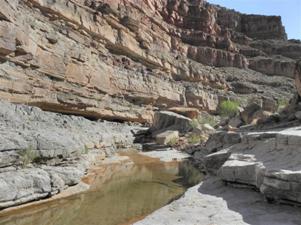

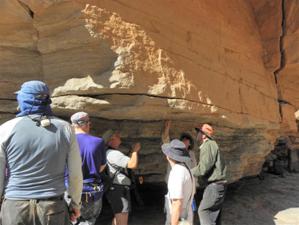
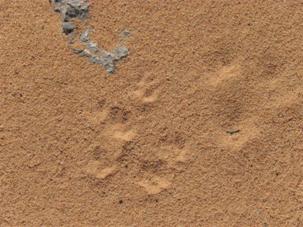
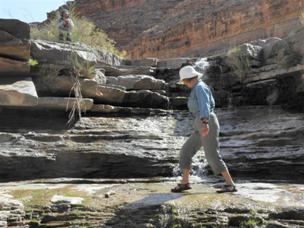

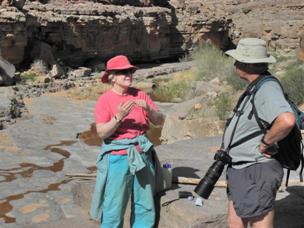
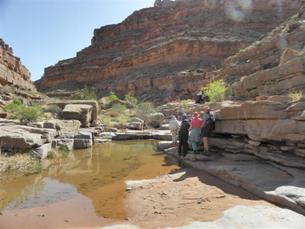



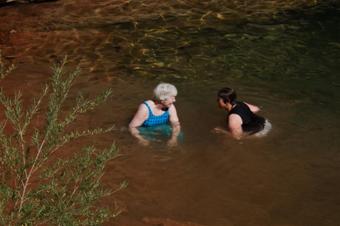
We continued upward. Striking red Devil’s Paintbrush flowers attracted a hummingbird. Harold explored further up the canyon also. When we hiked down there was no one in the pool – the perfect time for a quick swim before lunch.


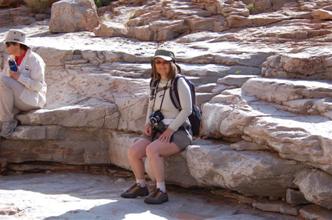
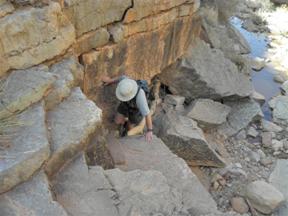



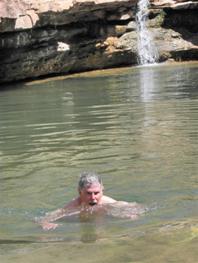
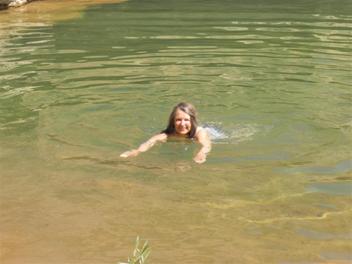
We had a short pleasant paddle to Grand Gulch Camp.

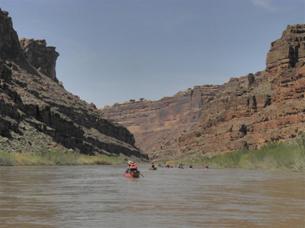
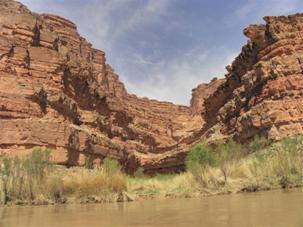
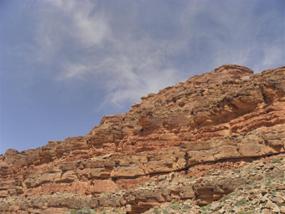


We camped along a ledge high over the river. Some campers set up their tents and then headed up the canyon.





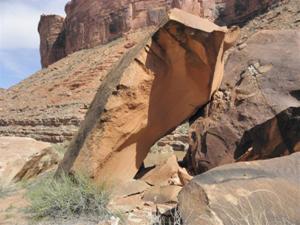
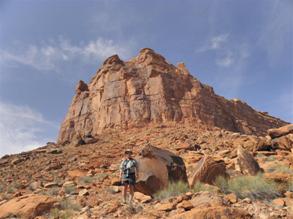
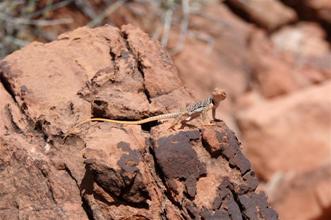
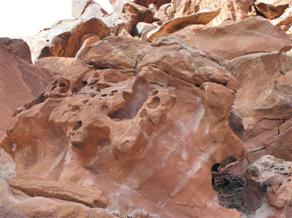

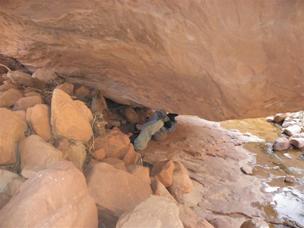

Kelvin went the furthest letting us know that were more rocks further up, so we returned, selecting a new route with Pierce’s help.

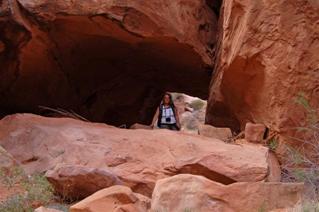

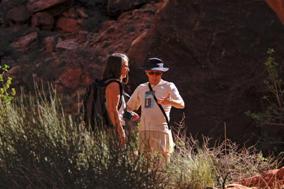




Another very special day to celebrate.
![]() New
Birds: April 15
New
Birds: April 15
San Juan River
39. Great-horned Owl (H)
40. Bushtit
41. Chipping Sparrow
42. Chukar

43. Hummingbird (sp)
44. Teal (sp)
Amphibian
Canyon Tree Frog (H)
DAY 7: SANDBARS - Friday, April 16
It was the final time to pack our tents and think about
our last day on the San Juan. Bill started his morning by showing Shauna a
video of their trip together down the Ross Rapid.
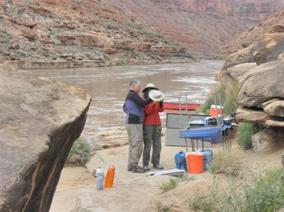
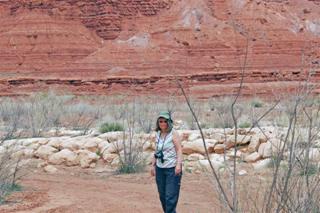
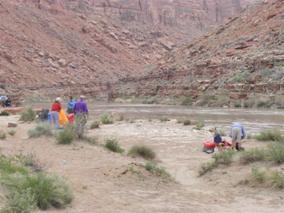
This last morning brought new paddling demands –
negotiating sandbars. As we neared the takeout at Clay Hills Crossing, we
entered the area where the river is very shallow due to large sand deposits.
When the Glen Canyon dam on the Colorado was built, and Lake Powell filled, the
last 70 miles of the San Juan was flooded all the way back to Slickhorn Canyon. When the silt laden river met this still
water, it dropped its load, and the sand is up to 80 feet thick! It was amazing
to see the large rafts negotiate around these invisible barriers. You have to
be able to read the water and weave from side to side down the river, keeping
to the deepest water which is often very close to the shore. Mostly we followed
Mike but we did get stuck twice.
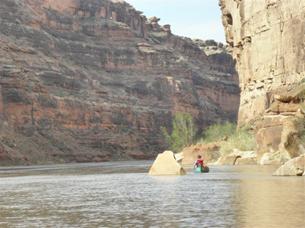
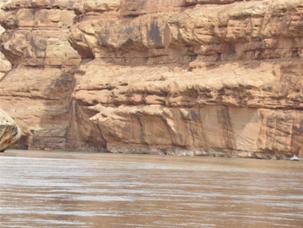
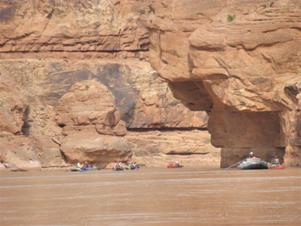
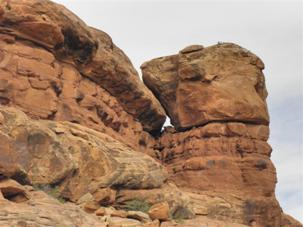
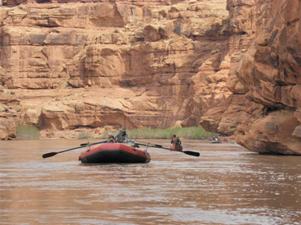
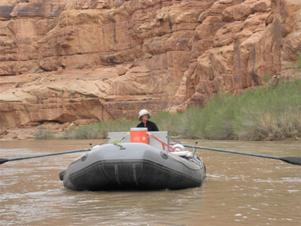
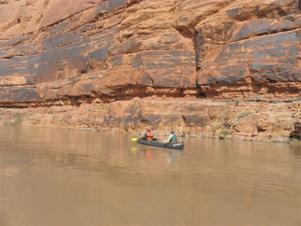

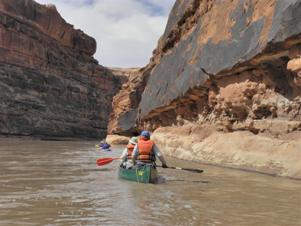

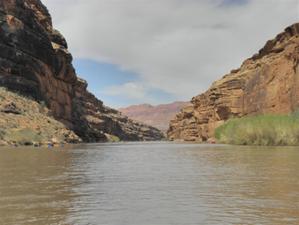
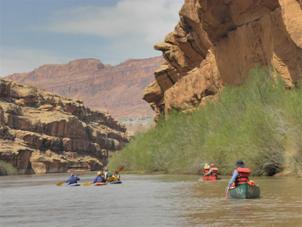
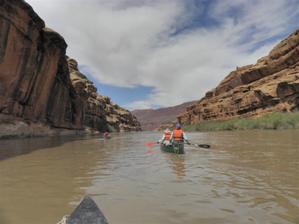
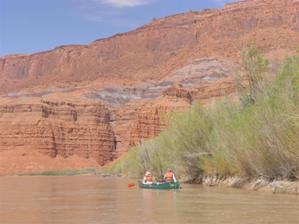
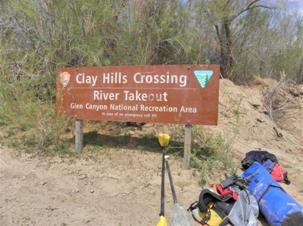
Now that the level of Lake Powell is way down, a 37-foot waterfall occurs shortly after Clay Hills Crossing. So all river trips must finish there. And there was Patty when we arrived – with two vans. And two dogs, warmly greeted by Pierce and Rafting Wendy. Lots of unloading and reloading, and a quick lunch. We did find time for a little birding by the vans.
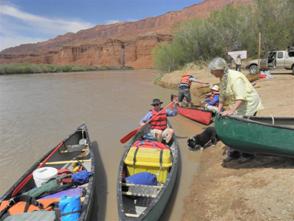
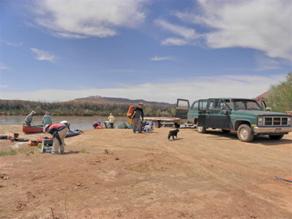
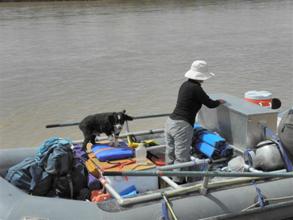
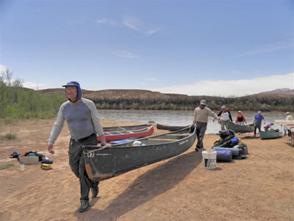

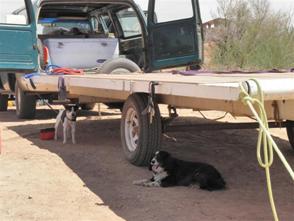

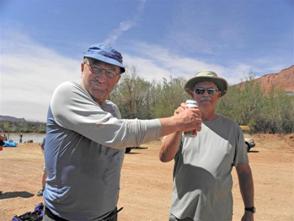
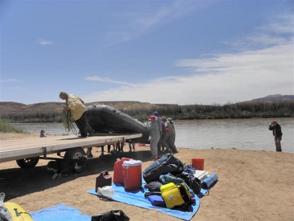
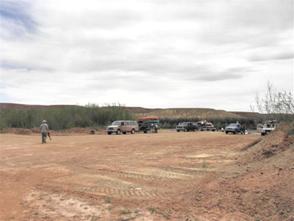
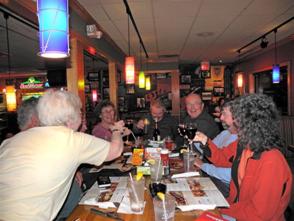
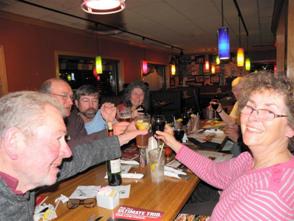
A nice ride back to Moab to unload the equipment and then a two hour drive to Grand Junction for showers and dinner out together. Thanks to drivers Mike and Patty for chauffeuring us.
A very memorable paddling adventure!
![]() New
Birds: April 16
New
Birds: April 16
San Juan River
45. Cinnamon Teal
46. Green-winged Teal
47. Peregrine Falcon
48. Common Yellowthroat (H)
49. Brewer’s
Blackbird

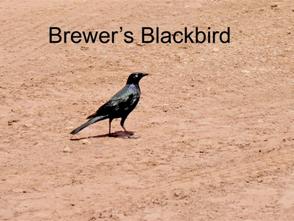
Grand
Canyon, Arizona and Moab, Utah: April 17- 24, 2010
Saturday, April 17, 2010
Travelling to Grand Canyon, Colorado
After our amazing
canoe trip, we picked up a rental Subaru Outback in Grand Junction, Colorado
and headed through Utah for the Grand Canyon in Arizona. Again we were very
pleased with our car rental upgrade. A perfect car for our
adventure travel. We could do the
mountain ads!
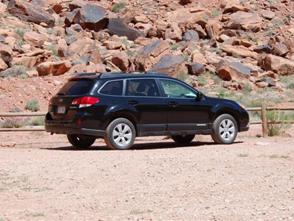
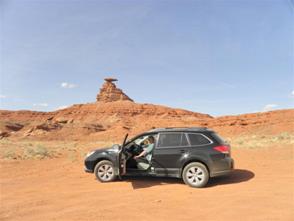
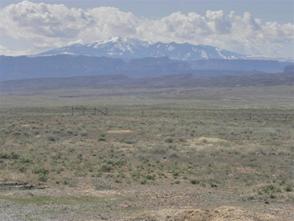
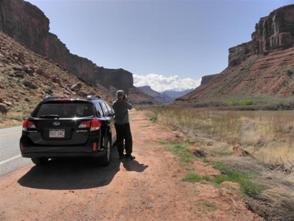
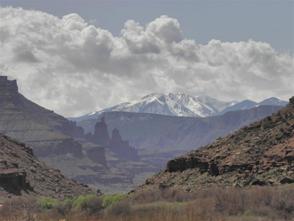
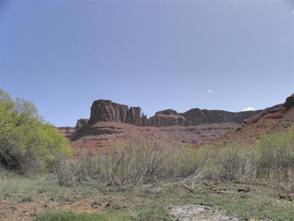
Although we retraced
some of the route through Utah as for our canoe trip, we were pleased to have
the time to stop and enjoy the desert scenery and spectacular red rock
monuments. We stopped at Wilson Arch south of Moab for lunch and were pleased
to discover birds at the picnic area, an Audubon’s Warbler and a Great-horned
Owl calling in the distance. As well, we hiked around the Mexican Hat monument
which we had paddled by on April 13; this time we checked out the San Juan from
above.
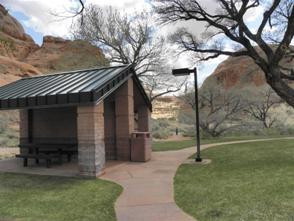
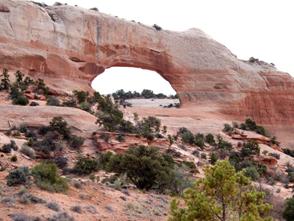
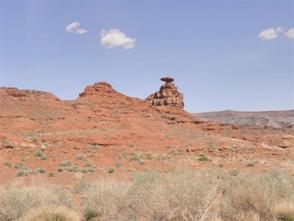
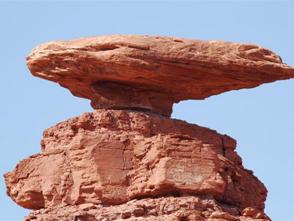
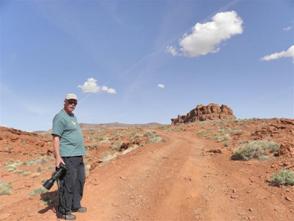
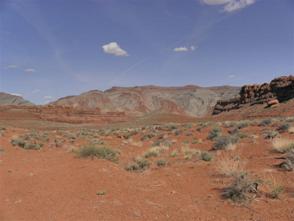
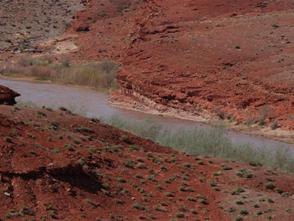
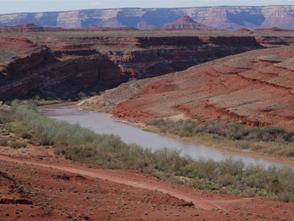
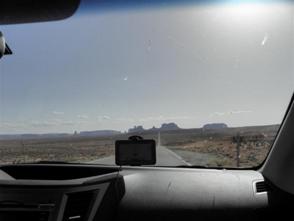
We travelled through Navaho land’s Monument Valley awestruck
by gigantic rock formations. These really stand out in the desert.

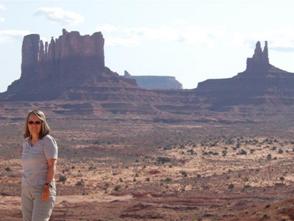
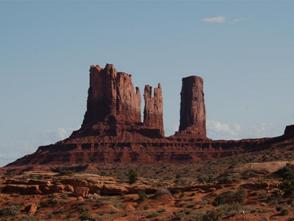
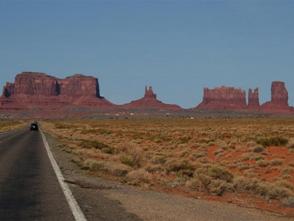
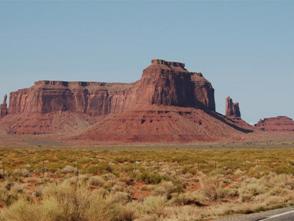
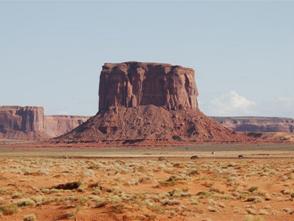
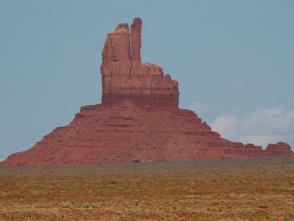
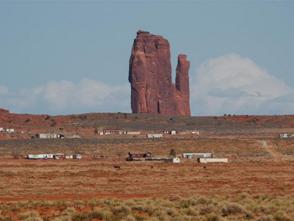
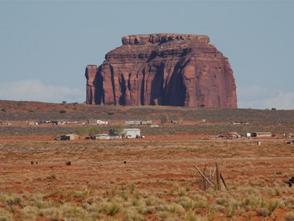
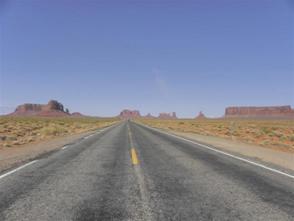
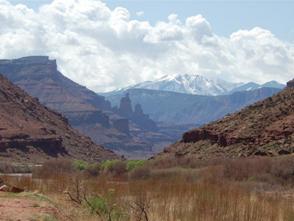
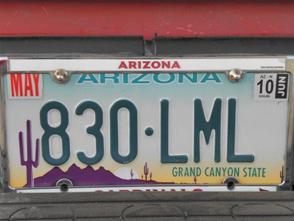
We made our way to Kayenta, Arizona where we found a Navaho-theme hotel,
Hampton Inn, which was just right for us.
![]() New
Birds: April 17
New
Birds: April 17
Wilson Arch, Utah
50. Audubon’s Warbler
51. Black-throated
Gray Warbler
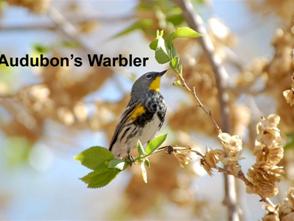
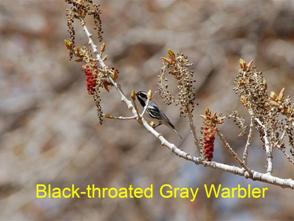
Sunday, April 18, 2010
Grand Canyon, Arizona
We woke to a
beautiful sunrise in Kayenta and were eager to set
out for the Grand Canyon. We were there by mid-morning. This was National Parks
Week so all entrances to US national parks and monuments were free, the very
week we visited several. So, no $25 entry fee to the Grand Canyon.
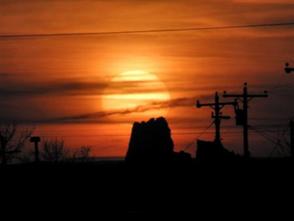
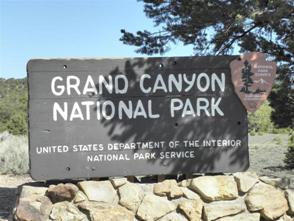
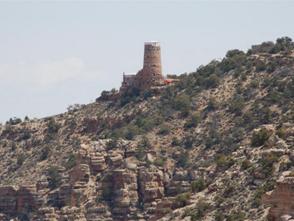
We enjoyed several
outlooks on the way to the Visitor Centre, doing a little birding at each one.
The first was a watchtower with the highest view in the park. It is a long way
down to the Colorado River. We stopped
at the Visitor Centre to case out the hikes and the birding. The canyon is very
wide, so quite a different perspective than the San Juan. Some snow patches
were still evident, interesting to see snow in the desert.

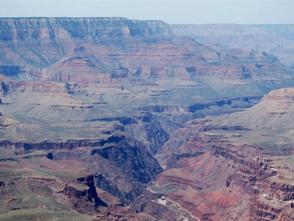
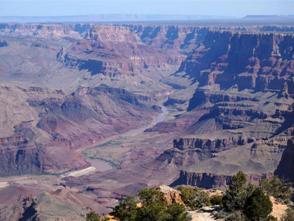
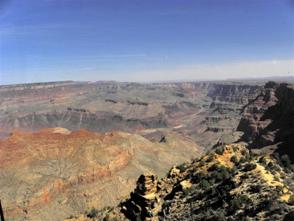

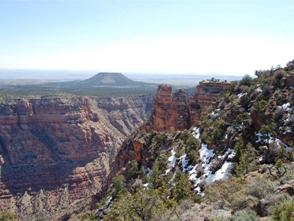
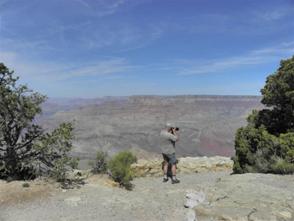
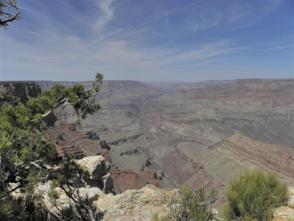
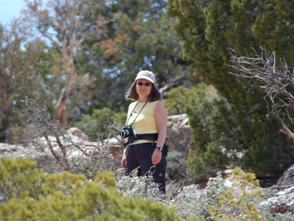

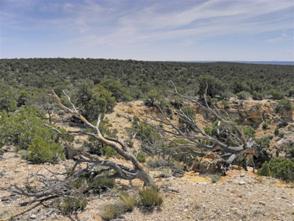
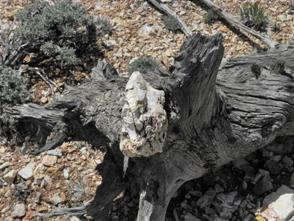
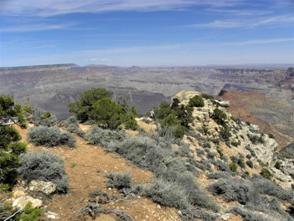
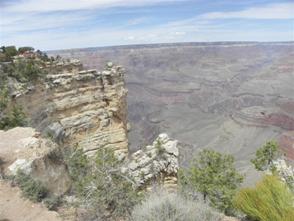


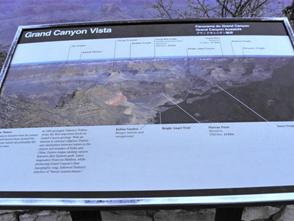
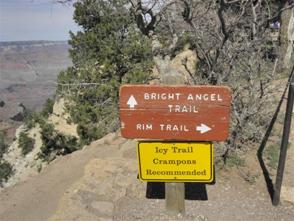
We had a reservation
at a Bright Angel Lodge cabin right on the canyon rim for Sunday night, so were
able to drive into the main village and not rely on bus shuttles.
We were ready!
Opportunely, our
cabin was right beside the Outlook where a ranger gave an hour-long talk
on California Condors. And... a condor flew right
over us while we were waiting for the talk and again during the talk. They are
massive birds with a nine foot wingspan. Although we did spot some again they
were very far away, so this close up look was very special.
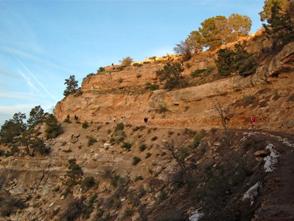
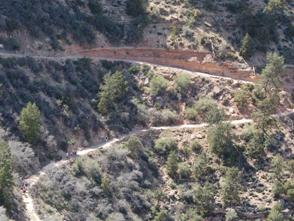
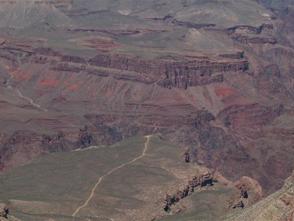
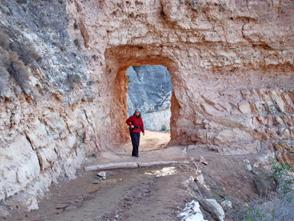
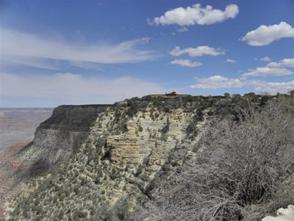
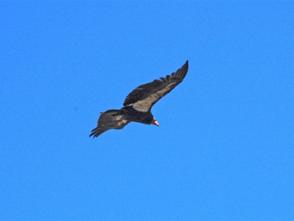
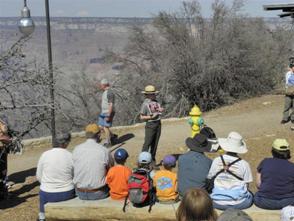
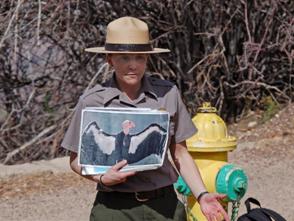
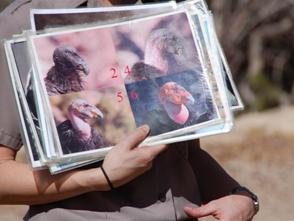
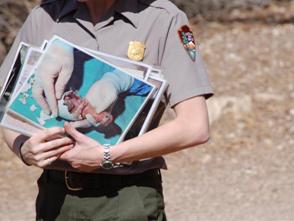
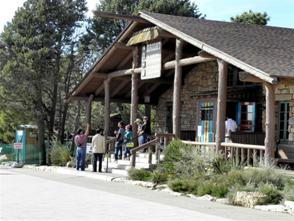
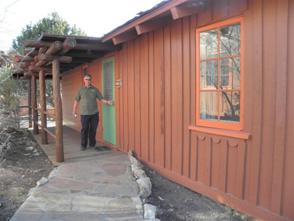
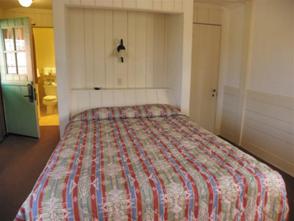
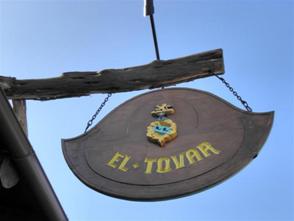
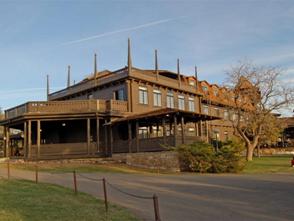
We decided to have
dinner at the famed El Tovar Hotel (rather like a CP hotel) next door to our
lodge/cabin. After an excellent dinner, we were ready for the famed sunset over
the canyon, right outside our cabin. Perfect. We viewed it from several angles,
the lowering sun highlighting the rich reds and oranges of the canyon walls.
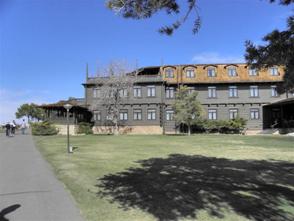
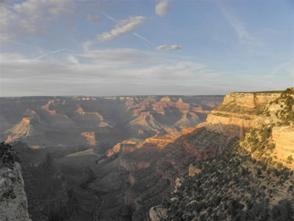
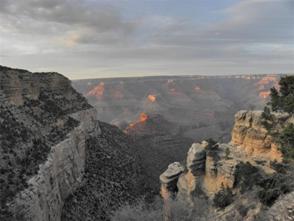
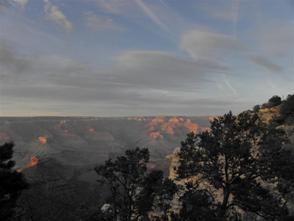
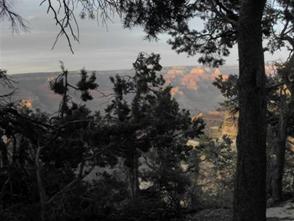
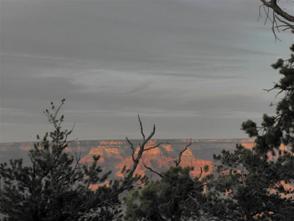
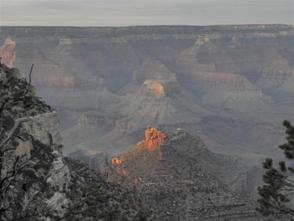
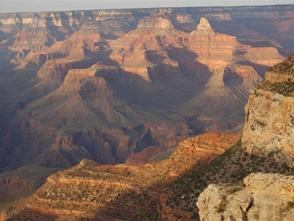
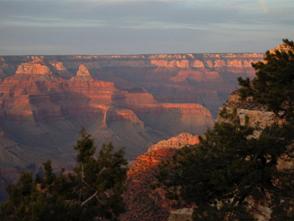
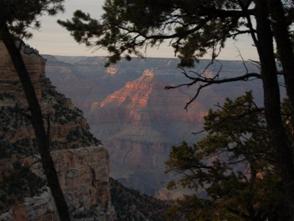
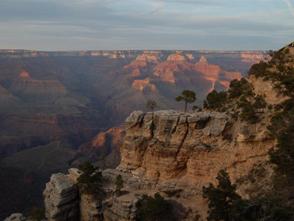
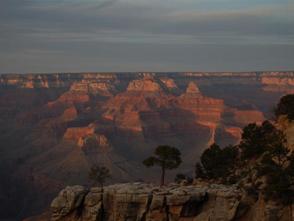
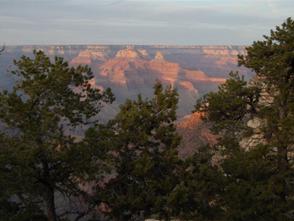
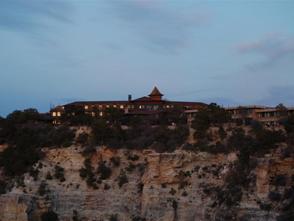
And at 6am the next
morning we were ready for the sunrise!
![]() New
Birds: April 18
New
Birds: April 18
Cameron
52. Western
Kingbird
53. Black-throated Sparrow

Grand Canyon
54. White-breasted Nuthatch
55. Eastern Bluebird
56. California Condor
57. Turkey
Vulture
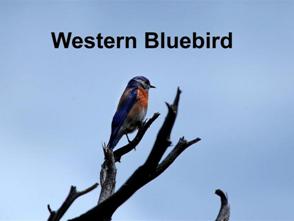
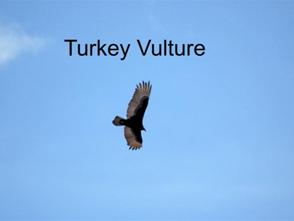
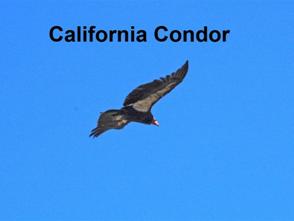
Monday, April 19, 2010
Grand Canyon, Arizona
Although we got up
early for the sunrise, it was cloudy so we did not get the bright colours. We had breakfast at our lodge with a canyon view.
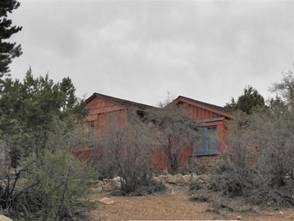
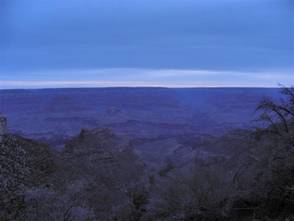

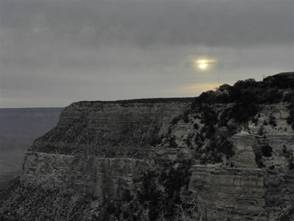
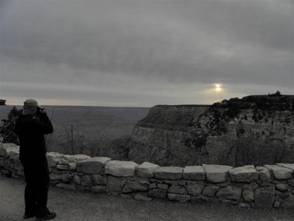
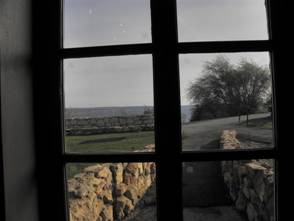
The day brought some
sun and some rain and wind. We took our raingear on our all-day hike. We hiked
the Rim Trail from the Grand Canyon village west to Hermit’s Point – several
hours and 9 miles = 14 km of canyon viewing and birding. The photos speak for
themselves. We were able to hop one of the transit buses back to the village.
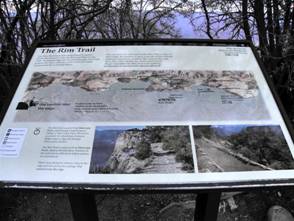
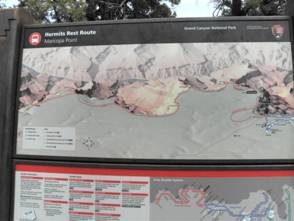
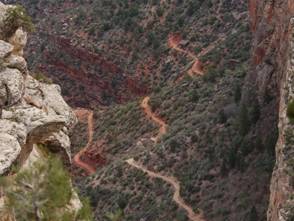
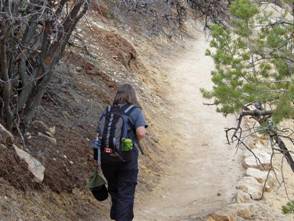
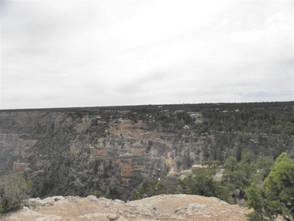
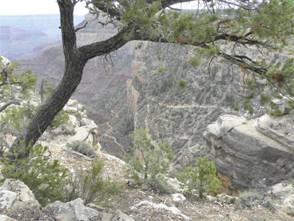
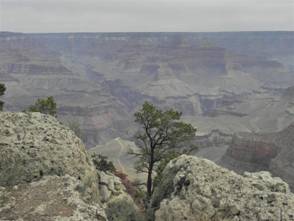
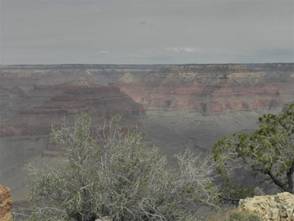
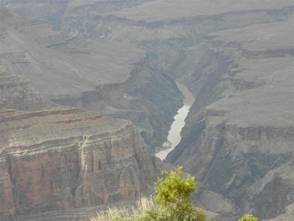
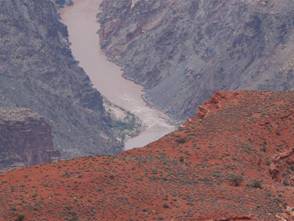
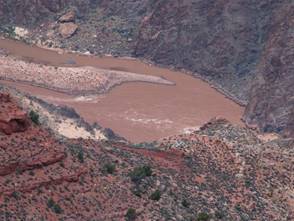

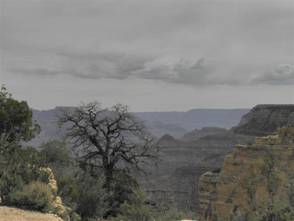

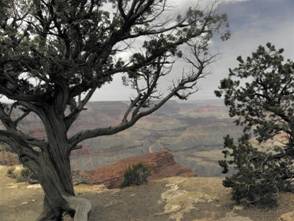

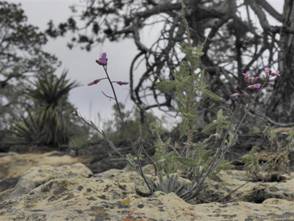
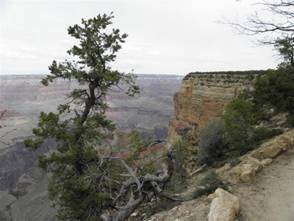
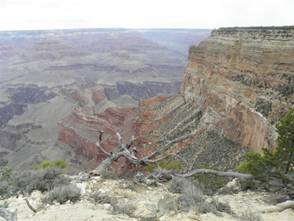
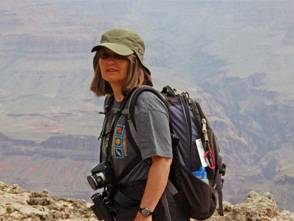
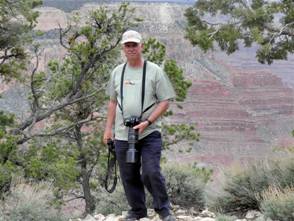
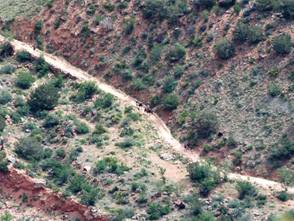
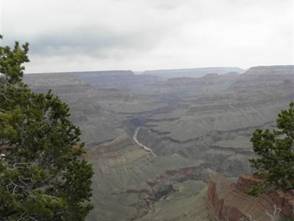
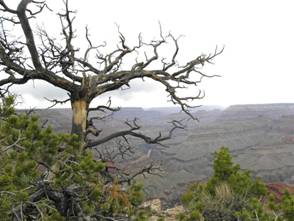
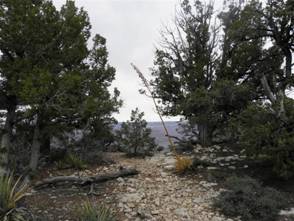
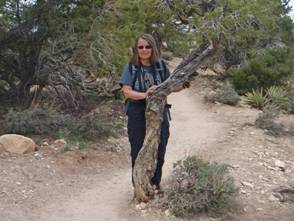
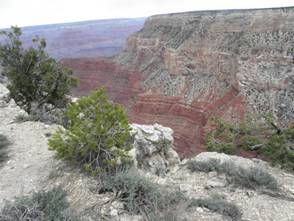
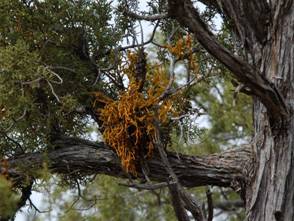
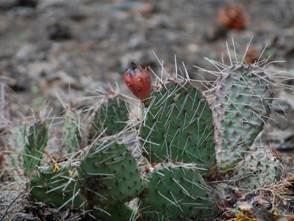
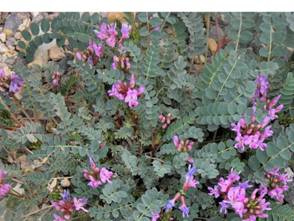
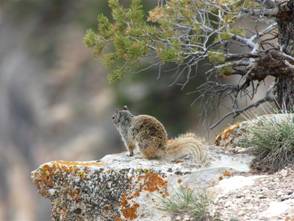
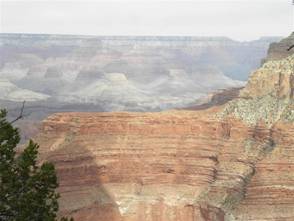



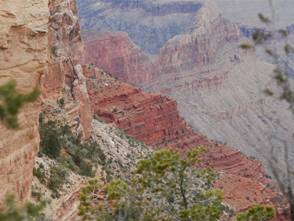
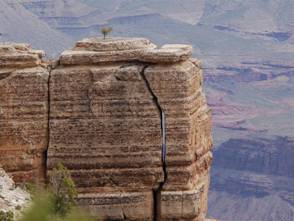
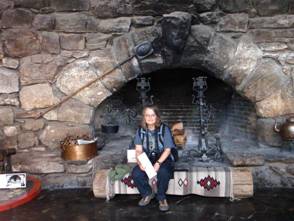
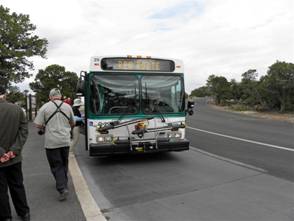
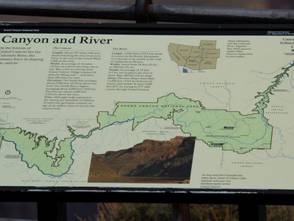

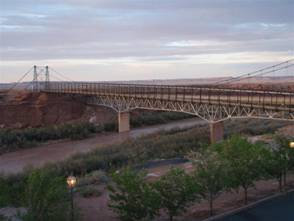
After a last look
around we hit the road for an hour’s drive to Cameron Trading Post 50 miles
east of the park where we had a reservation – it’s right on the Little Colorado
River, so more scenic views... Also, it
turned out to be a warbler birding hot spot as it has large trees and beautiful
lush garden.
![]() New
Birds: April 19
New
Birds: April 19
Grand Canyon
58. Townsend’s
Solitaire
59. Saw-whet
Owl (H)
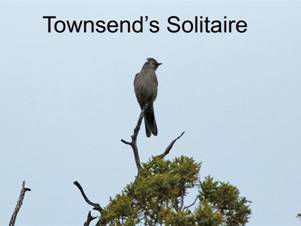
Tuesday, April 20, 2010
Travelling to Moab, Utah
We had an hour of
birding in the early morning at Cameron Trading Post, such an inviting garden.
As well, Barbara chatted with a Navaho woman who was weaving rugs. She said a
small one such as she was working on would take her two months and one on the
large loom would take a year. The hardest part is creating a vision of the
finished product. Each one is original.
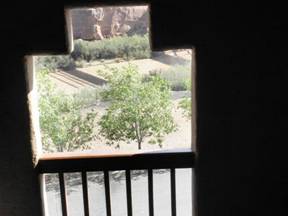
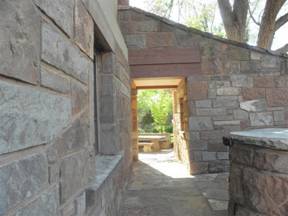
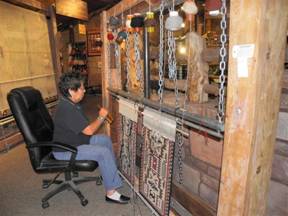
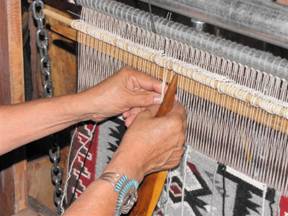
We returned to Kayenta. On the way we spotted an American Avocet and the
three types of teal on a pond.
In Kayenta we toured a Navaho home reconstruction, called hogans – both male and female. As well, there was a display
on WWII Navaho code talkers who developed a code undecipherable to the
Japanese.
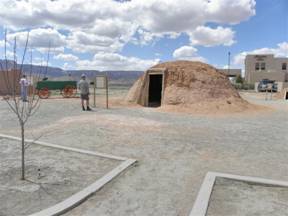
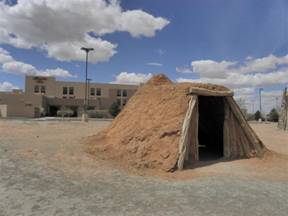
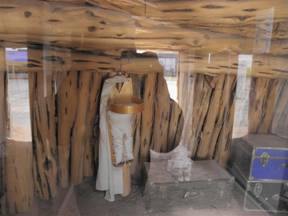
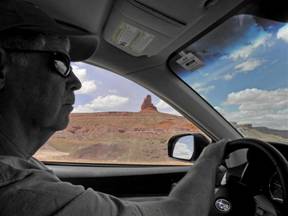
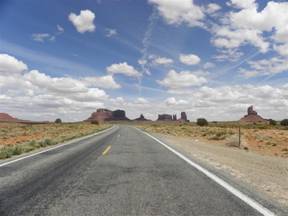
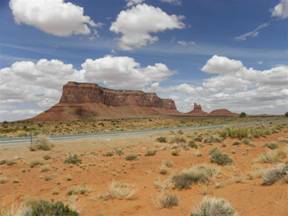
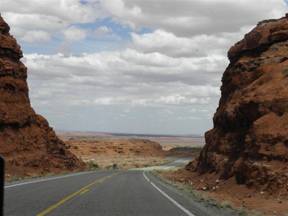
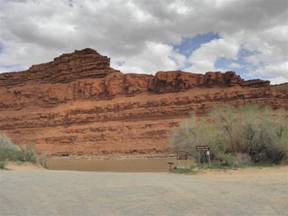
To complete our visit
to SW USA, we wanted to check out the sites at Moab, Utah, particularly the
remarkable stone arches. On our return trip to Moab, we made several
interesting spots.
We stopped at our Mexican Hat San Juan hotel store again for more ice cream. Also we checked out some birds on a pond near the boat launch and discovered a surprise - some Northern Shovellers.
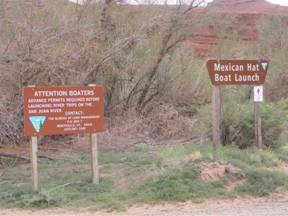
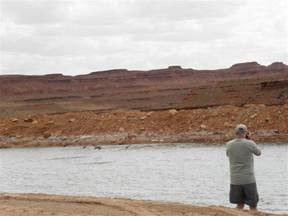
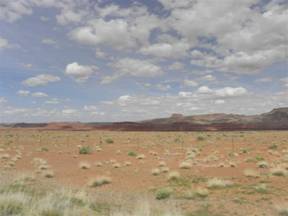
The rest of our drive
focused on more natural wonders: Goosenecks State Reserve overlook was a new
look at our San Juan River where we had paddled this largest gooseneck one week
ago, on April 13.
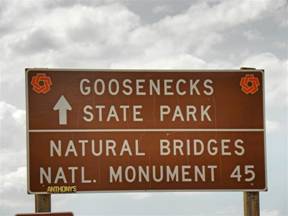


We decided to travel
a northern loop to Natural Bridges National Monument rather than retrace our
steps. We were very surprised to have to negotiate Moki
Dugway road with a very scary one way gravel road
going up a mountain - switchbacks with no railings. This was a gooseneck road.
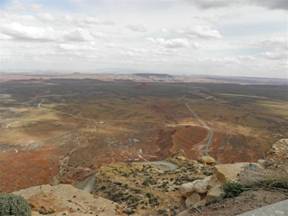

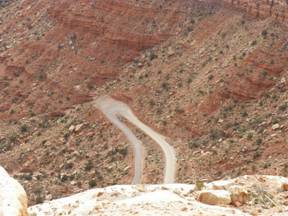
We were grateful to
arrive safely at Natural Bridges National Monument (still free!). The sandstone
bridges were impressive – we could drive close to three of them. Bridges are formed
by water erosion while arches are formed by other natural factors, e.g., wind,
chemical breakdown.
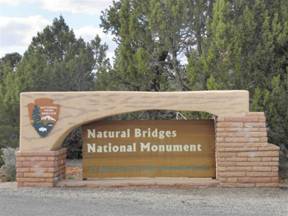
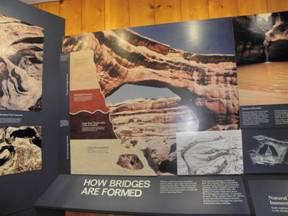
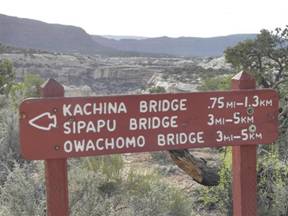
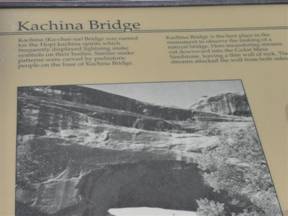
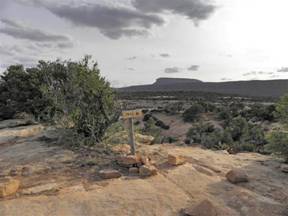
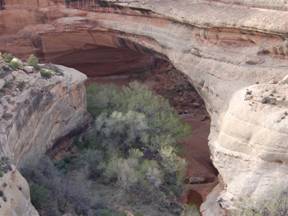
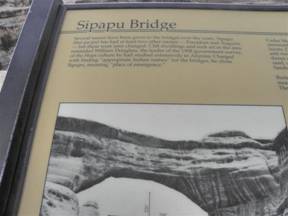
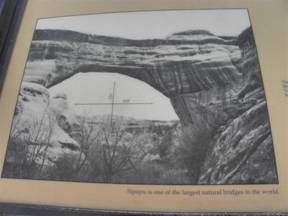
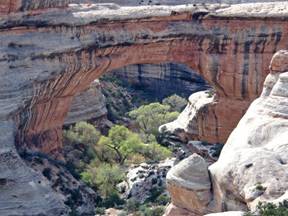
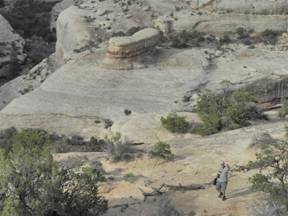
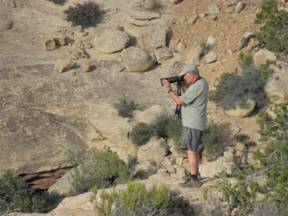
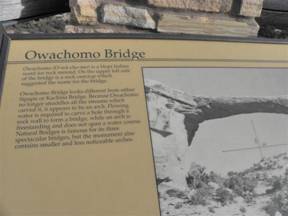
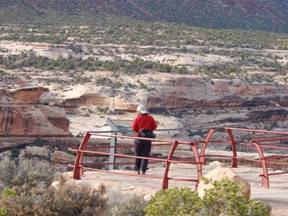
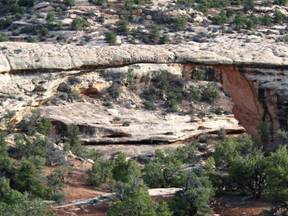
We negotiated a curvy
road and found our way to Blanding. We stopped for the night and started
planning our Moab adventure.
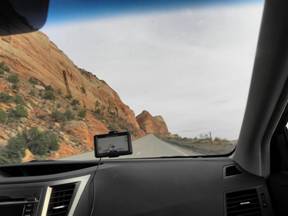
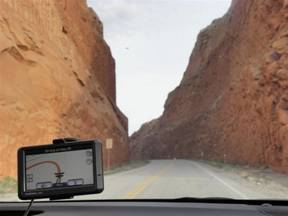
![]() New
Birds: April 20
New
Birds: April 20
Cameron, Arizona
60. Wilson’s
Warbler
61. Great-tailed
Grackle
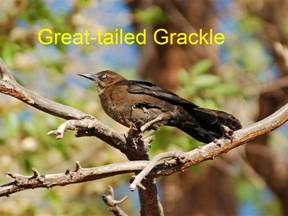
Kayenta, Arizona
62. American
Avocet
63. American
Coot

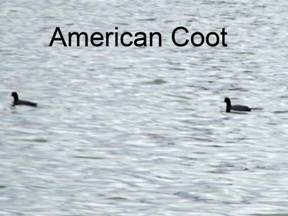
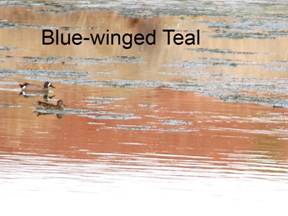
Mexican Hat, Utah
64. Northern
Shoveller
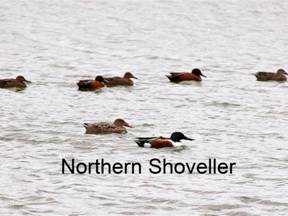
Wednesday, April 21, 2010
Moab, Utah
As Blanding is close
to Moab, we were almost there. We started our day at a nearby sewage pond where
we had an excellent view of a Yellow-headed Blackbird. Near the highway we saw
some pronghorn antelope grazing in a field.
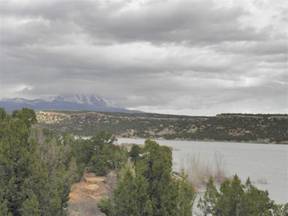
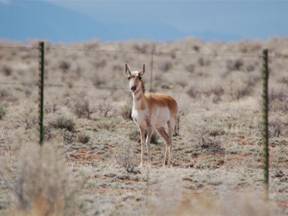
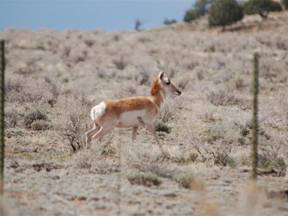
We decided to drive
to Needles, a part of Canyonlands National Park. It was long drive. We stopped part way at
campground with a a
self-guided nature hike. Our binoculars were busy. When we arrived at Needles, the weather was
hazy and threatening rain. We did not get a good view of these monuments. On the
way back we did spot a golden eagle soaring over a field, battling the wind.
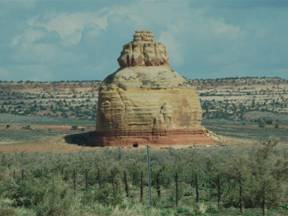
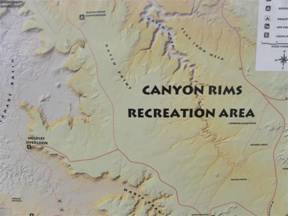
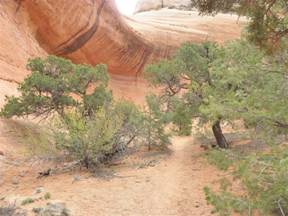
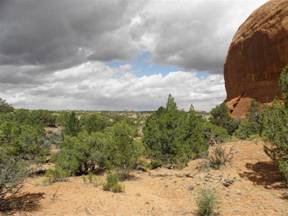
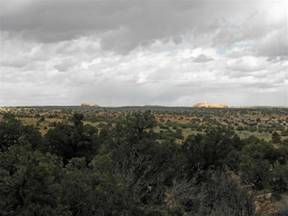
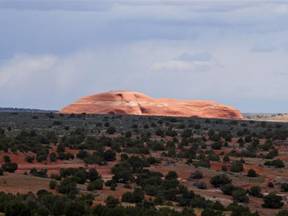
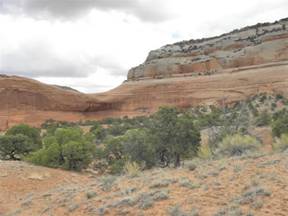
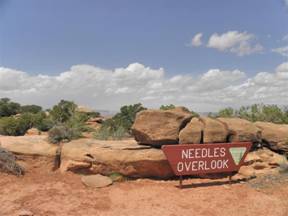
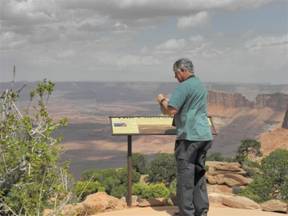
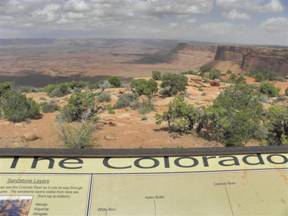
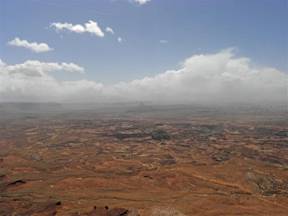
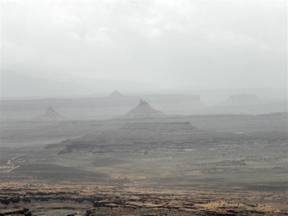

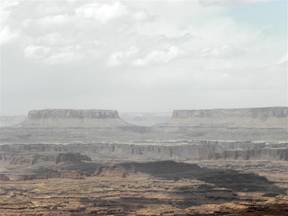
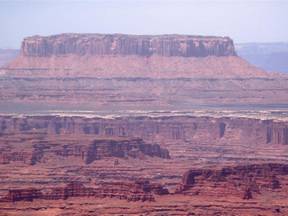
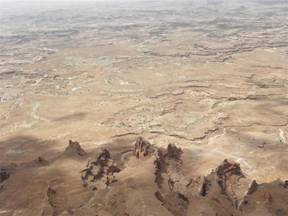
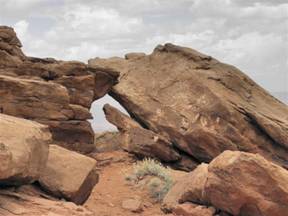
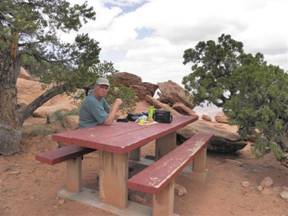


At Moab we checked
out the Visitor Centre and the Matheson Wetlands Preserve, where we had good
views of Spotted Towhees. Although the Preserve is being restored due to a fire
last fall, we were able to enter, dodging boardwalk repairs and tree trimming.
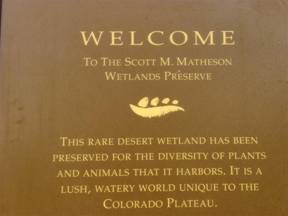
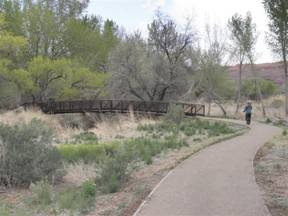
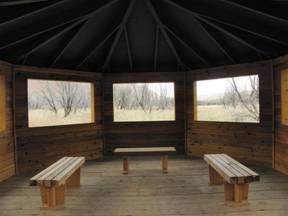
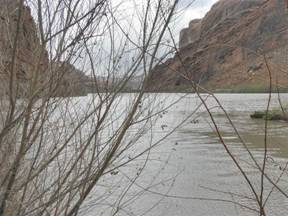
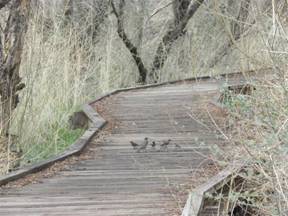
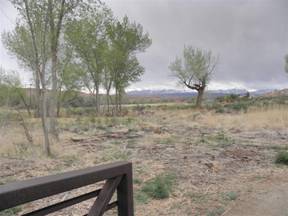
We checked into the
Holiday Inn Express for two nights. Supper at the Moab Brewery was a fun experience
testing the local beer.
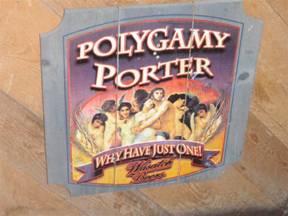
![]() New
Birds: April 21
New
Birds: April 21
Blanding, Utah
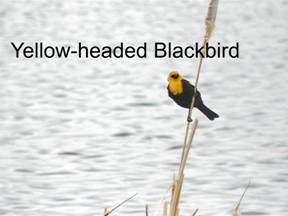
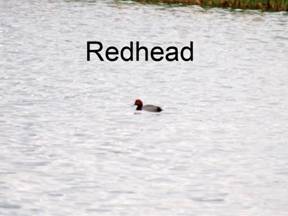
65. Yellow-headed
Blackbird
66. Redhead
67. Eastern
Meadowlark
Moab – Matheson
Wetlands Preserve
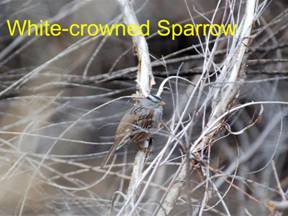
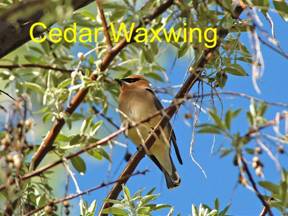
68. Blue
Grosbeak
69. Cedar
Waxwing
70. Spotted
Towhee
71. White-crowned
Sparrow
Thursday, April 22, 2010
Moab, Utah
This day was
magnificent. As we pulled out of the parking lot to head to Arches National
Park, we saw some mountain bikers heading out too, with a different idea of how
to have fun in the park.
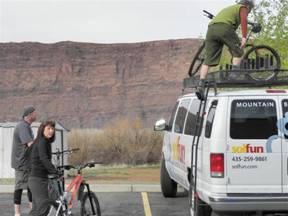
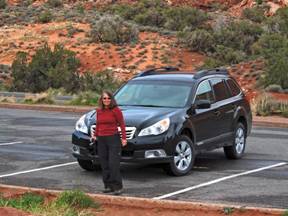
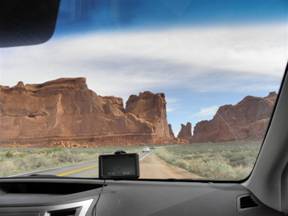
We were delighted with
incredible arches, our favourites
the famed Delicate Arch (strenuous hike – 3 hours), the Windows, Double Arch
and Sand Arch. Bill bravely ventured in front of a dramatic drop off to stand
under the Delicate Arch and scrambled up under the dramatic Double Arch. This
park was definitely a trip high point (in more ways than one).
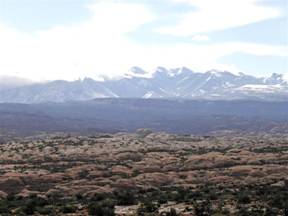
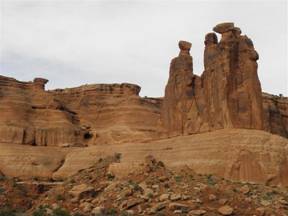
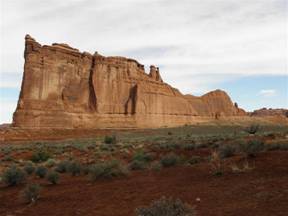
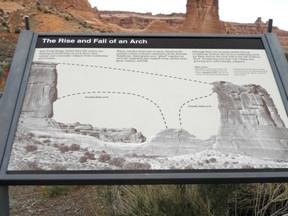
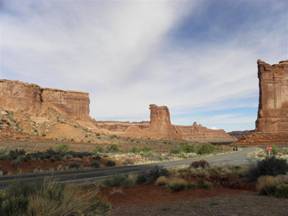
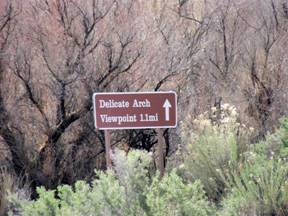
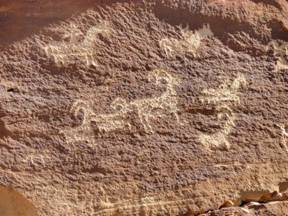
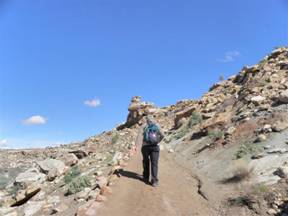

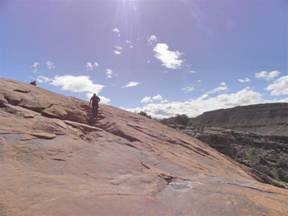
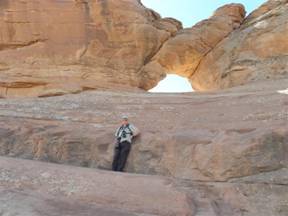
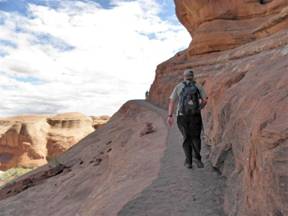
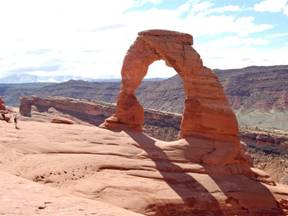

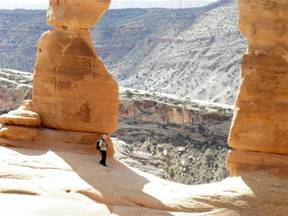
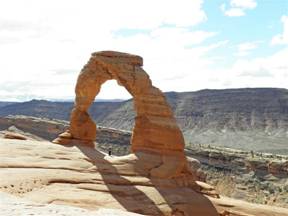
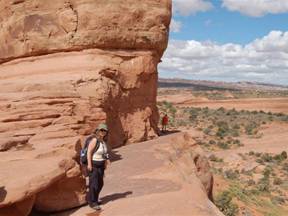
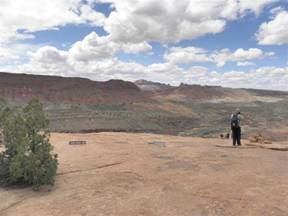
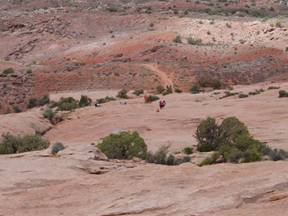
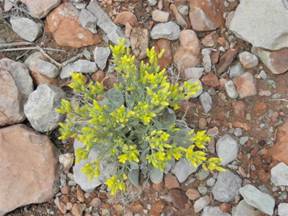
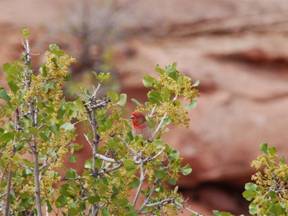
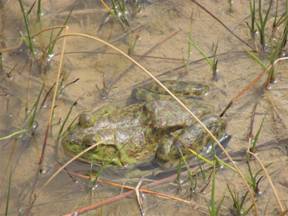
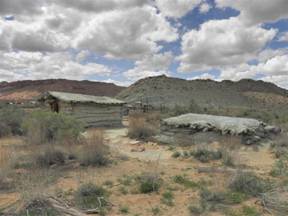
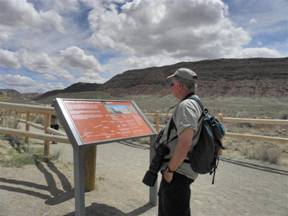
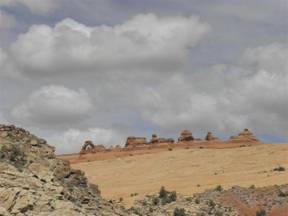
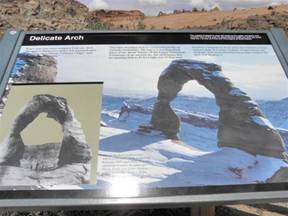
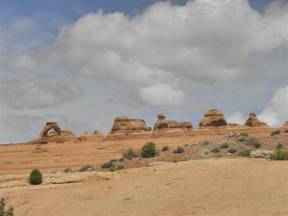
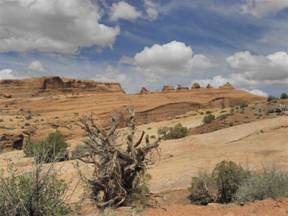
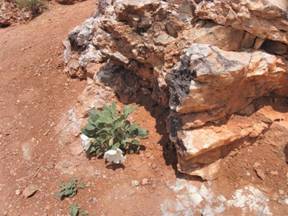
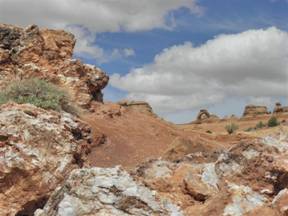

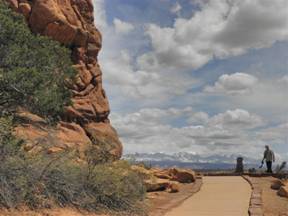
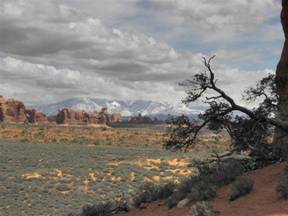
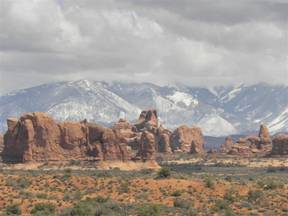
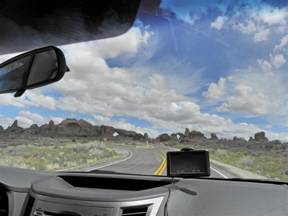
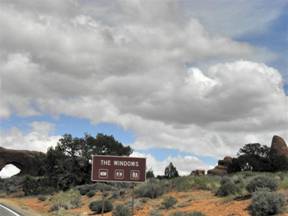
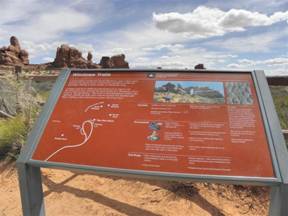
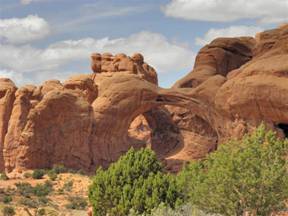
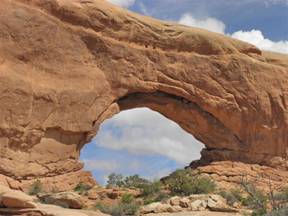
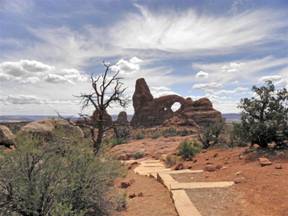
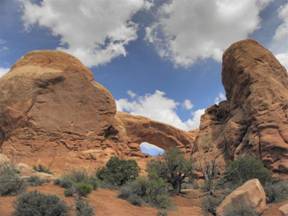
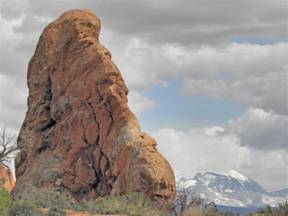
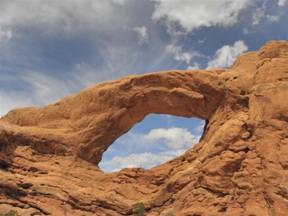
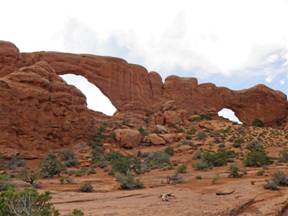
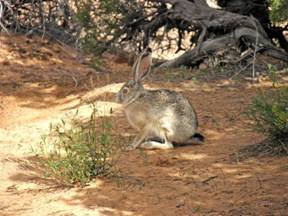
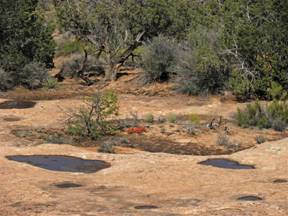
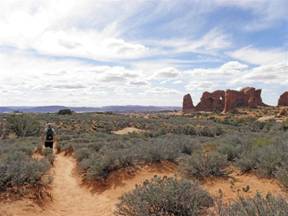
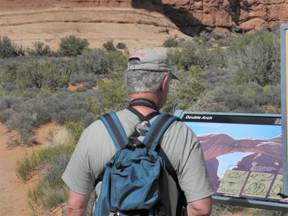
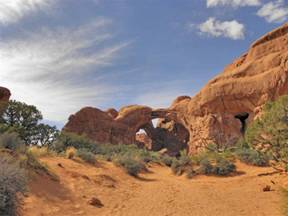
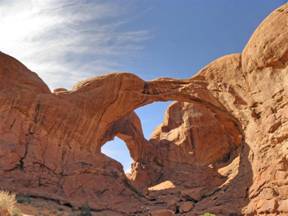
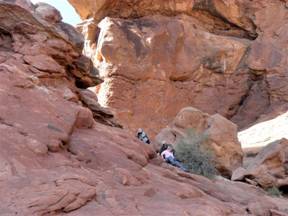
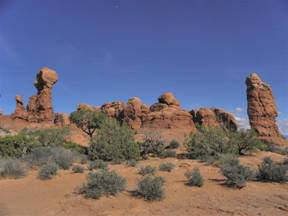
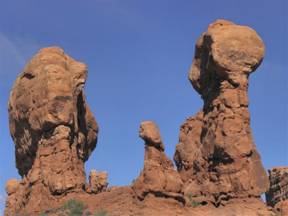
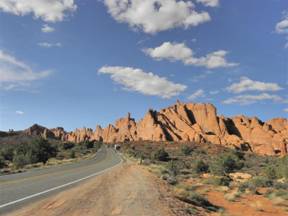
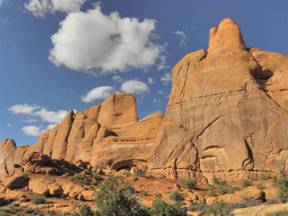
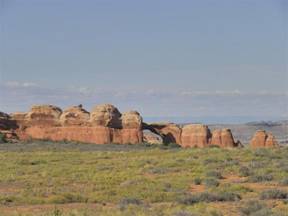
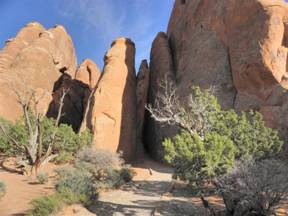
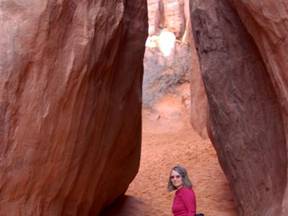
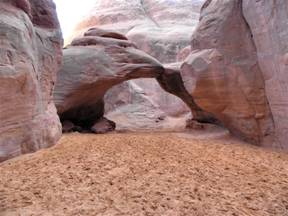
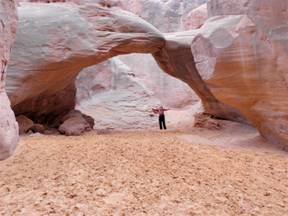
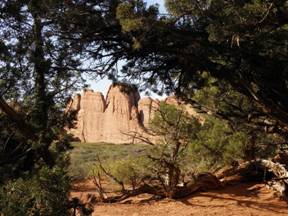
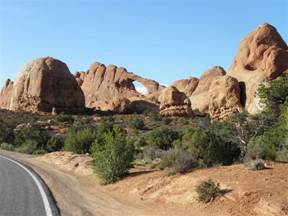
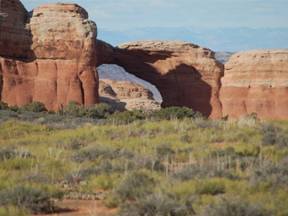
We also had good
views of two rock climbers ascend and rappel down a vertical peak at the Garden
of Eden.
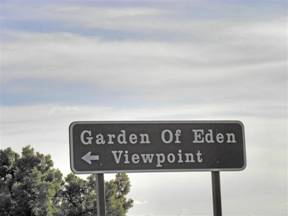

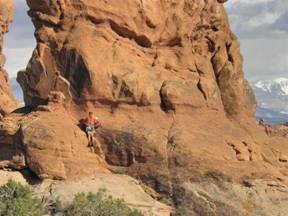
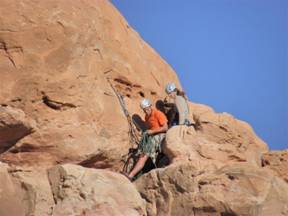
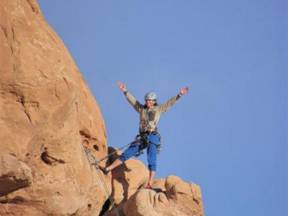
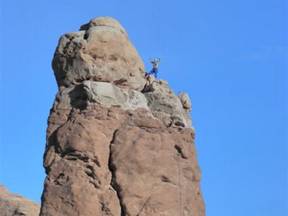
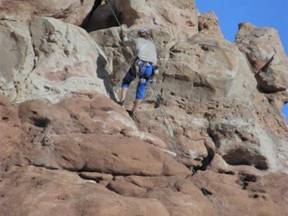
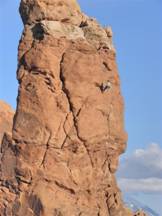
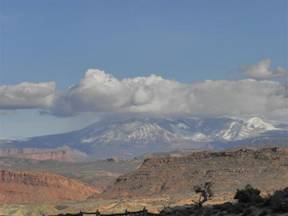
We loved being able
to hike around the structures rather than just view them from afar. Incredible memories.
Thursday, April 22, 2010
Moab, Utah
Bill started his day
with another hike through the Matheson Wetlands Preserve. Barbara checked out a few stores in Moab –
quite a touristy area – catering to mountain bikers, dirt bikers, off-roaders, rafters and climbers. We visited Moab National
Park a final time and took a short hike in a canyon, Park Avenue Trail.
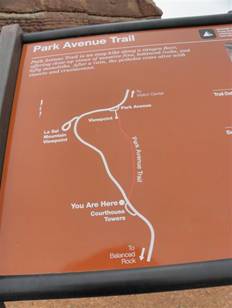
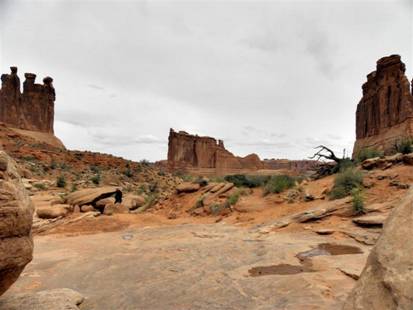
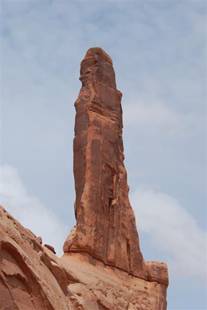
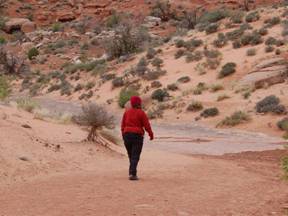
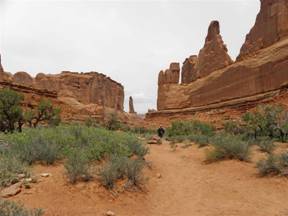
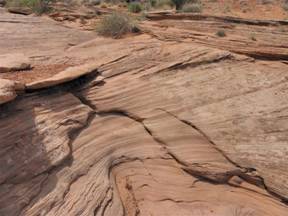
Then we were ready
for lunch at Eddie McStiff’s, a neat roadhouse in
Moab. A climbing shop nearby referred us
to Potash Road where we found several rock climbers.
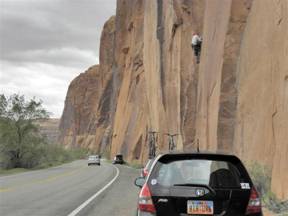
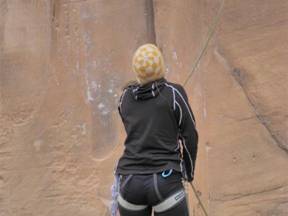
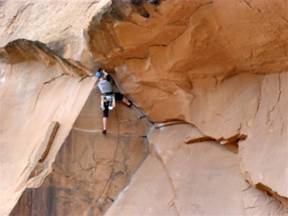
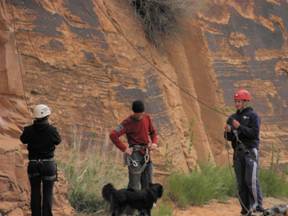
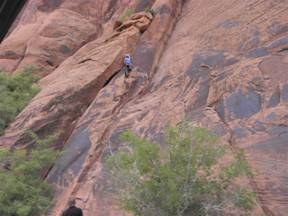
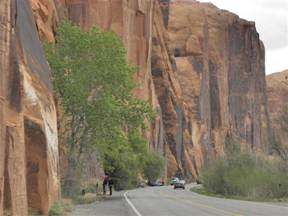
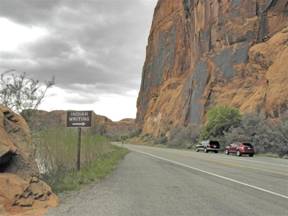
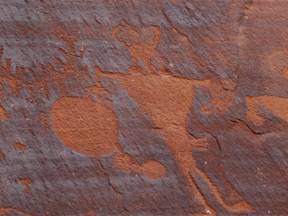
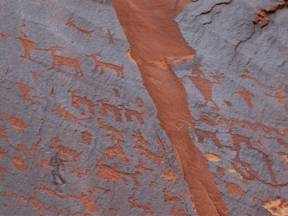
Then it was time to
return to Grand Junction and prepare for our trip home early tomorrow morning.

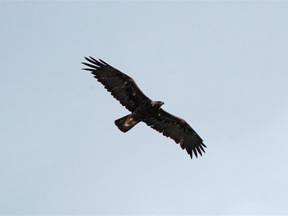
![]() New
Birds: April 21
New
Birds: April 21
Moab – Matheson Wetlands Preserve
72. Tennessee
Warbler ?
73. Lesser
Goldfinch
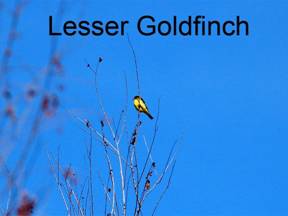
En route to Grand
Junction
74. Wild
Turkey
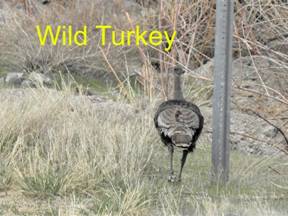
Canyons, rapids, first nations, birds, monuments - many
things to reflect on as we head home.
